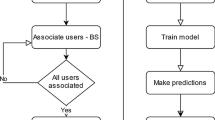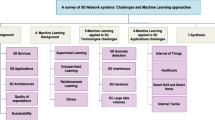Abstract
The rapid increase in the volume of devices connected to mobile networks poses unprecedented demands on existing networking infrastructures. Machine Learning is a promising technique, already applied in various sectors of our everyday lives. It enables decision making not with the use of traditional programming but rather by using data to train models to cope with various problems without explicit programming on how to do so. The integration of Machine Learning techniques is deemed necessary in as many processes as possible to help the network face congestion and enable efficient real time decision making. In this paper we present two Machine Learning based mechanisms for improving real time user allocation on the network as well as predicting the best positioning scheme for Smallcell Base Stations to provide effective utilization of the network’s resources.
Access this chapter
Tax calculation will be finalised at checkout
Purchases are for personal use only
Similar content being viewed by others
References
Yang, J., Wang, C., Wang, X., Shen, C.: A Machine Learning Approach to User Association in Enterprise Small Cell Networks, pp. 850–854 (2018). https://doi.org/10.1109/ICCChina.2018.8641148
Mahbub, M.: A smart farming concept based on smart embedded electronics, internet of things and wireless sensor network. Internet of Things 9, 1–30 (2020). https://doi.org/10.1016/j.iot.2020.100161
Sun, Y., Peng, M., Zhou, Y., Huang, Y., Mao, S.: Application of machine learning in wireless networks: key techniques and open issues. IEEE Commun. Surv. Tutorials. 21(4), 3072–3108 (2019). https://doi.org/10.1109/COMST.2019.2924243
Mom, J.M., Ani, C.: Application of self-organizing map to intelligent analysis of cellular networks. ARPN J. Eng. Appl. Sci. 8, 407–412 (2013)
Rokach, L., Maimon, O.: Data mining with decision trees. Theory and Applications (2008). https://doi.org/10.1142/9789812771728-0001
Shi, M., Yang, K., Xing, C., Fan, R.: Decoupled heterogeneous networks with millimeter wave small cells. IEEE Trans. Wireless Commun. 17(9), 5871–5884 (2017). https://doi.org/10.1109/TWC.2018.2850897
Elshaer, H., Boccardi, F., Dohler, M., Irmer, R.: Downlink and uplink decoupling: a disruptive architectural design for 5G networks (2014). https://doi.org/10.1109/GLOCOM.2014.7037069
Feng, Z., Li, W., Chen, W.: Downlink and uplink splitting user association in two-tier heterogeneous cellular networks. In: 2014 IEEE Global Communications Conference (GLOBECOM 2014), pp. 4659–4664 (2015). https://doi.org/10.1109/GLOCOM.2014.7037543
Ghosh, A., Raha, A., Mukherjee, A.: Energy-efficient IoT-health monitoring system using approximate computing. Internet of Things. 9, 100166 (2020). https://doi.org/10.1016/j.iot.2020.100166
Sun, S., Adachi, K., Tan, P.H., Zhou, Y., Joung, J., Ho, C.K.: Heterogeneous network: an evolutionary path to 5G, pp. 174–178 (2015) https://doi.org/10.1109/APCC.2015.7412506
Cheung, Y.: K*-means: a new generalized k-means clustering algorithm. Pattern Recogn. Lett. 24, 2883–2893 (2003). https://doi.org/10.1016/S0167-8655(03)00146-6
Boostanimehr, H., Bhargava, V.: Unified and distributed QoS-driven cell association algorithms in heterogeneous networks. In: IEEE Transactions on Wireless Communications. vol. 14 (2014). https://doi.org/10.1109/TWC.2014.2371465
Author information
Authors and Affiliations
Corresponding author
Editor information
Editors and Affiliations
Rights and permissions
Copyright information
© 2021 The Author(s), under exclusive license to Springer Nature Switzerland AG
About this paper
Cite this paper
Bouras, C., Kalogeropoulos, R. (2021). User Allocation in 5G Networks Using Machine Learning Methods for Clustering. In: Barolli, L., Woungang, I., Enokido, T. (eds) Advanced Information Networking and Applications. AINA 2021. Lecture Notes in Networks and Systems, vol 225. Springer, Cham. https://doi.org/10.1007/978-3-030-75100-5_2
Download citation
DOI: https://doi.org/10.1007/978-3-030-75100-5_2
Published:
Publisher Name: Springer, Cham
Print ISBN: 978-3-030-75099-2
Online ISBN: 978-3-030-75100-5
eBook Packages: Intelligent Technologies and RoboticsIntelligent Technologies and Robotics (R0)




